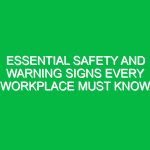Introduction
Hello team! Today, we’re gathering for this toolbox talk to discuss an essential topic that can significantly impact our work and personal lives: Dealing with Stress from Home. As many of us continue to navigate remote work or a blended working model, understanding how to manage stress effectively is crucial for our well-being and productivity. Stress isn’t just a minor inconvenience; it can lead to various health issues and can affect our performance on the job. Let’s explore practical strategies to help us cope with stress while working from home, ensuring a healthier work Environment for everyone.
Understanding Stress
Before we dive into the strategies, let’s take a moment to understand what stress is. Stress is the body’s response to challenges or demands, which can be both physical and emotional. When working from home, the boundaries between personal and professional life can blur, leading to increased stress levels. Recognizing stress is the first step in Dealing with Stress from Home. Common signs of stress include:
- Feeling overwhelmed or anxious
- Difficulty concentrating
- Changes in sleep patterns
- Physical symptoms like headaches or stomach problems
- Reduced productivity and motivation
Understanding these signs can help you identify when stress is impacting your work and personal life. The goal of our discussion is to equip you with effective tools to manage this stress proactively.
Strategies for Dealing with Stress from Home
1. Establish a Dedicated Workspace
Creating a dedicated workspace is one of the most effective strategies for Dealing with Stress from Home. Your workspace should be distinct from your personal space, which helps in mentally separating work from home life. Here are a few tips to create an effective workspace:
- Choose a quiet area with minimal distractions.
- Ensure your workspace is comfortable and ergonomic.
- Personalize your space with items that motivate you.
- Keep your workspace organized to promote clarity and focus.
By establishing a routine around your workspace, you create a structure that can significantly reduce stress and enhance productivity.
2. Set Clear Boundaries
Setting boundaries is crucial when working from home. It’s easy to fall into the trap of working longer hours or being always available. Here’s how to define those boundaries:
- Establish specific work hours and stick to them.
- Communicate your availability to colleagues and family members.
- Use tools like calendars or scheduling apps to manage your time effectively.
- Designate times for breaks and lunch to recharge.
Clear boundaries help in maintaining a healthy work-life balance, which is essential for Dealing with Stress from Home.
3. Practice Mindfulness and Relaxation Techniques
Mindfulness and relaxation techniques are powerful tools for managing stress. They help center your thoughts and promote a sense of calm. Here are some practices you can incorporate into your daily routine:
- Meditation: Spend a few minutes each day focusing on your breath or using guided meditation apps.
- Deep Breathing: Practice deep breathing exercises, especially before meetings or challenging tasks.
- Progressive Muscle Relaxation: Tense and relax each muscle group in your body to release tension.
- Yoga or Stretching: Incorporate short yoga sessions or stretching exercises to relieve physical stress.
These techniques not only help in Dealing with Stress from Home but also enhance overall mental clarity and focus.
4. Stay Connected
Social connection is vital for mental health, especially when working remotely. Make it a point to stay in touch with your colleagues. Here’s how to foster those connections:
- Schedule regular check-ins with your team.
- Use video calls to maintain face-to-face interactions.
- Participate in virtual team-building activities.
- Share experiences and challenges with colleagues to foster a supportive environment.
By staying connected, you can combat feelings of isolation and stress, making it easier to navigate the challenges of working from home.
5. Prioritize Physical Health
Maintaining physical health is crucial when you’re Dealing with Stress from Home. A healthy body contributes to a healthy mind. Here are some tips to prioritize your physical health:
- Exercise Regularly: Aim for at least 30 minutes of physical activity each day, whether it’s a workout, walking, or yoga.
- Eat Well: Focus on a balanced diet rich in fruits, vegetables, whole grains, and lean proteins.
- Stay Hydrated: Drink plenty of water throughout the day to keep your body functioning optimally.
- Get Adequate Sleep: Aim for 7-9 hours of quality sleep each night to recharge your body and mind.
By prioritizing your physical health, you build resilience against stressors that may arise during your workday.
6. Manage Your Time Wisely
Effective time management is key to reducing stress. When you manage your time well, you can minimize last-minute pressure and workload. Here are some strategies:
- Use a Planner: Keep a planner to schedule tasks and deadlines.
- Break Tasks into Smaller Steps: Divide larger projects into manageable tasks to avoid feeling overwhelmed.
- Set Priorities: Identify the most critical tasks for the day and focus on completing them first.
- Avoid Multitasking: Focus on one task at a time for better concentration and efficiency.
Effective time management not only reduces stress but also enhances productivity, allowing you to achieve your goals with less strain.
Potential Hazards and Risks
While working from home, several potential Hazards can contribute to stress. These include:
- Isolation and lack of social interaction
- Increased workload or unclear job expectations
- Ergonomic issues leading to physical discomfort
- Distractions from home life affecting focus
Recognizing these hazards is the first step in mitigating their Effects. By implementing the strategies discussed, you can create a safer and more productive work environment.
Regulations and Standards
It’s important to note that there are Regulations and company policies regarding mental health and Workplace Safety. Familiarizing yourself with these can help you understand your rights and responsibilities while working from home. Compliance with these standards not only promotes a safe working environment but also protects the organization legally. Make sure to review your company’s policies on mental health and stress management, as they may provide you with additional resources and support.
Conclusion
As we conclude our toolbox talk on Dealing with Stress from Home, remember that managing stress is not just an individual responsibility; it’s a collective effort. By applying the strategies we discussed today—creating a dedicated workspace, setting boundaries, practicing mindfulness, staying connected, prioritizing physical health, and managing time wisely—you can significantly reduce stress and enhance your productivity. Thank you all for your attention and commitment to maintaining a safe and healthy work environment. Let’s support one another in implementing these practices and fostering a positive workplace culture.


